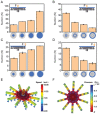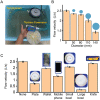Glowing Sucker Octopus (Stauroteuthis syrtensis)-Inspired Soft Robotic Gripper for Underwater Self-Adaptive Grasping and Sensing
- PMID: 35388640
- PMCID: PMC9189663
- DOI: 10.1002/advs.202104382
Glowing Sucker Octopus (Stauroteuthis syrtensis)-Inspired Soft Robotic Gripper for Underwater Self-Adaptive Grasping and Sensing
Abstract
A soft gripper inspired by the glowing sucker octopus (Stauroteuthis syrtensis)' highly evolved grasping capability enabled by the umbrella-shaped dorsal and ventral membrane between each arm is presented here, comprising of a 3D-printed linkage mechanism used to actuate a modular mold silicone-casting soft suction disc to deform. The soft gripper grasp can lift objects using the suction generated by the pump in the soft disc. Moreover, the protruded funnel-shaped end of the deformed suctorial mouth can adapt to smooth and rough surfaces. Furthermore, when the gripper contacts the submerged target objects in a turbid environment, local suctorial mouth arrays on the suction disc are locked, causing the variable flow inside them, which can be detected as a tactile perception signal to the target objects instead of visual perception. Aided by the 3D-printed linkage mechanism, the soft gripper can grasp objects of different shapes and dimensions, including flat objects, objects beyond the grasping range, irregular objects, scattered objects, and a moving turtle. The results report the soft gripper's versatility and demonstrate the vast application potentials of self-adaptive grasping and sensing in various environments, including but are not limited to underwater, which is always a key challenge of grasping technology.
Keywords: bioinspiration; glowing sucker octopus; self-adaptive grasping; soft gripper.
© 2022 The Authors. Advanced Science published by Wiley-VCH GmbH.
Conflict of interest statement
The authors declare no conflict of interest.
Figures








Similar articles
-
Octopus-Inspired Underwater Soft Robotic Gripper with Crawling and Swimming Capabilities.Research (Wash D C). 2024 Aug 28;7:0456. doi: 10.34133/research.0456. eCollection 2024. Research (Wash D C). 2024. PMID: 39206446 Free PMC article.
-
A Bioinspired Soft Swallowing Gripper for Universal Adaptable Grasping.Soft Robot. 2022 Feb;9(1):36-56. doi: 10.1089/soro.2019.0106. Epub 2020 Dec 3. Soft Robot. 2022. PMID: 33275516
-
Octopus Arm-Inspired Tapered Soft Actuators with Suckers for Improved Grasping.Soft Robot. 2020 Oct;7(5):639-648. doi: 10.1089/soro.2019.0082. Epub 2020 Feb 25. Soft Robot. 2020. PMID: 32096693
-
Variable stiffness soft robotic gripper: design, development, and prospects.Bioinspir Biomim. 2023 Nov 22;19(1). doi: 10.1088/1748-3190/ad0b8c. Bioinspir Biomim. 2023. PMID: 37948756 Review.
-
Comparison of Different Technologies for Soft Robotics Grippers.Sensors (Basel). 2021 May 8;21(9):3253. doi: 10.3390/s21093253. Sensors (Basel). 2021. PMID: 34066680 Free PMC article. Review.
Cited by
-
Soft Microdenticles on Artificial Octopus Sucker Enable Extraordinary Adaptability and Wet Adhesion on Diverse Nonflat Surfaces.Adv Sci (Weinh). 2022 Nov;9(31):e2202978. doi: 10.1002/advs.202202978. Epub 2022 Aug 17. Adv Sci (Weinh). 2022. PMID: 35975453 Free PMC article.
-
The evolution of surgical precision: addressing and advancing the hardware of robotic end-effectors.Surg Endosc. 2025 Aug;39(8):4765-4772. doi: 10.1007/s00464-025-11963-3. Epub 2025 Jul 10. Surg Endosc. 2025. PMID: 40640622 Review.
-
Octopus-Inspired Underwater Soft Robotic Gripper with Crawling and Swimming Capabilities.Research (Wash D C). 2024 Aug 28;7:0456. doi: 10.34133/research.0456. eCollection 2024. Research (Wash D C). 2024. PMID: 39206446 Free PMC article.
-
Octopus-Inspired Adhesives with Switchable Attachment to Challenging Underwater Surfaces.Adv Sci (Weinh). 2025 Jan;12(1):e2407588. doi: 10.1002/advs.202407588. Epub 2024 Oct 9. Adv Sci (Weinh). 2025. PMID: 39380495 Free PMC article.
-
Advanced Bionic Attachment Equipment Inspired by the Attachment Performance of Aquatic Organisms: A Review.Biomimetics (Basel). 2023 Feb 16;8(1):85. doi: 10.3390/biomimetics8010085. Biomimetics (Basel). 2023. PMID: 36810416 Free PMC article. Review.
References
-
- Stuart H. S., Wang S. Q., Gardineer B., Christensen D. L., Aukes D. M., Cutkosky M., IEEE Int. Conf. Rob. Autom. IEEE, New York: 2014, p. 6691.
-
- Barratt D. M., Harch P. G., Van Meter K., Neurologist 2002, 8, 186. - PubMed
-
- Gong Z. Y., Fang X., Chen X. Y., Cheng J. H., Xie Z. X., Liu J. Q., Chen B. H., Yang H., Kong S. H., Hao Y. F., Wang T. M., Yu J. Z., Wen L., Int. J. Rob. Res. 2021, 40, 449.
-
- Rus D., Tolley M. T., Nature 2015, 521, 467. - PubMed
-
- Siciliano B., Khatib O., Springer Handbook of Robotics, Springer, Berlin‐Heidelberg, Germany: 2008.
Publication types
MeSH terms
Grants and funding
LinkOut - more resources
Full Text Sources
